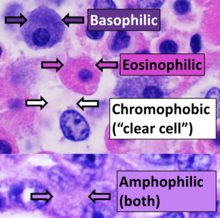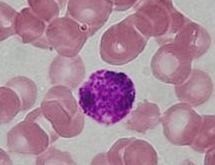Eosinophilic


Eosinophilic (Greek suffix -phil-, meaning loves eosin) is the staining of tissues, cells, or organelles after they have been washed with eosin, a dye.
Eosin is an acidic dye for staining cell cytoplasm, collagen, and muscle fibers.[1][2] Eosinophilic describes the appearance of cells and structures seen in histological sections that take up the staining dye eosin.[2] Such eosinophilic structures are, in general, composed of protein.[3]
Eosin is usually combined with a stain called hematoxylin to produce a hematoxylin- and eosin-stained section (also called an H&E stain, HE or H+E section). It is the most widely used histological stain for a medical diagnosis.[3] When a pathologist examines a biopsy of a suspected cancer, they will stain the biopsy with H&E.
Some structures seen inside cells are described as being eosinophilic; for example, Lewy and Mallory bodies.[4] Some cells are also described as eosinophilic, such as Leukocytes.[5]
See also
[edit]- Basophilic (affinity to hematoxylin)
- Eosinophil
- Eosinophilia
- Eosinophilic meningitis
- Acidophile (histology)
References
[edit]- ^ Tubbs, R. Shane; Rizk, Elias; Shoja, Mohammadali; Loukas, Marios; Barbaro, Nicholas; Spinner, Robert J. (2015). Nerves and Nerve Injuries: Vol 1: History, Embryology, Anatomy, Imaging, and Diagnostics. Academic Press. p. 84. ISBN 978-0-12-410447-1.
- ^ a b Sharma, Sonal; Khanna, Geetika (2019). Textbook of Pathology and Genetics for Nurses E-Book. Elsevier Health Sciences. p. 9. ISBN 978-8-13-125538-4.
- ^ a b Leong, Franz Joel; Dartois, Veronique; Dick, Thomas (2016). A Color Atlas of Comparative Pathology of Pulmonary Tuberculosis. CRC Press. p. 199. ISBN 978-1-43-983530-2.
- ^ Eosinophilic. Medline Plus. Accessed March 2nd, 2012.
- ^ Dixon, Frank J. (1986). Advances in Immunology, Volume 39. Academic Press. p. 323. ISBN 9780120224395.
